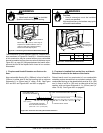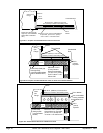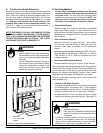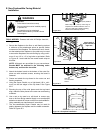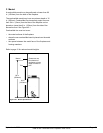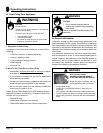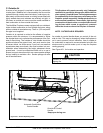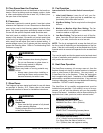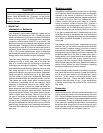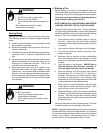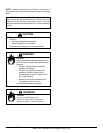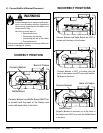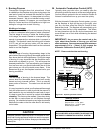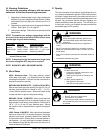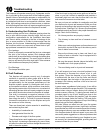
September 1, 2008
September 1, 2008
Heat & Glo • NorthStar EPA Fireplace • 480-1081C
Page 47
CAUTION
ALLwiringshouldbedonebyaqualiedelectricianand
shall be in compliance with local codes and with the National
ElectricCodeNFPA/NEC No. 70-current(inthe United
States), or with the current CSC22.1 Canadian Electric
Code (in Canada).
I. Wood Fuel
Hardwood vs. Softwood
Yourreplace’sperformancedependsagreatdealon
thequalityoftherewoodyouuse.Contrarytopopular
belief, one species of wood varies very little to the other in
terms of energy content. All seasoned wood, regardless
of species, contains about 8,000 BTU’s per pound. The
important factor is that hardwoods have a greater density
than softwoods. Therefore, a piece of hardwood will con-
tain about 60% more BTU’s than an equal size piece of
softwood.Sincerewoodiscommonlysoldbythecord
(128 cu. ft) a volume measurement, a cord of seasoned
oak (hardwood) would contain about 60% more potential
energy than a cord of seasoned pine (softwood).
Therearemanydenitionsofhardwoodandsoftwood.
Although not true in every case, one of the most reli-
able is to classify them as coniferous or deciduous.
Softwoods are considered coniferous. These are trees
with needle-like leaves that stay green all year and carry
their seeds exposed in a cone. Examples of softwood
treesareDouglasr,pine,spruceandcedar.Softwoods,
being more porous, require less time to dry, burn faster
and are easier to ignite than hardwoods. Deciduous
trees are broadleaf trees that lose their leaves in the fall.
Their seeds are usually found within a protective pod
or enclosure. Hardwoods fall into this category. Some
examples of deciduous trees are oak, maple, apple,
and birch. However, it should be noted that there are
somedeciduoustreesthataredenitelynotconsidered
hardwoods such as poplar, aspen and alder. Hardwoods
require more time to season, burn slower and are usually
hardertoignitethansoftwoods.Obviously,youwilluse
the type of wood that is most readily available in your
area. However, if at all possible the best arrangement is
to have a mix of softwood and hardwood. This way you
canusethesoftwoodforstartingtheregivingoffquick
heat to bring the appliance up to operating temperature.
Then add the hardwood for slow, even heat and longer
burn time.
Moisture content
Regardless of which species of wood you burn, the single
mostimportantfactorthataffectsthewayyourreplace
operates is the amount of moisture in the wood. The
majorityoftheproblemsreplace ownersexperience
are caused by trying to burn wet, unseasoned wood.
Freshly cut wood can be as much water as it is wood,
having a moisture content of around 50%. Imagine a
wooden bucket that weighs about 8 pounds. Fill it with a
gallonofwater,putitinthereboxandtrytoburnit.This
sounds ridiculous but that is exactly what you are doing
if you burn unseasoned wood. Dead wood lying on the
forestoorshouldbeconsideredwet,andrequiresfull
seasoning time. Standing dead wood can be considered
to be about two-thirds seasoned, if cut at the dry time
of the year.
The problems with burning wet, unseasoned wood are
two fold. First, you will receive less heat output from wet
wood because it requires energy in the form of heat to
evaporate the water trapped inside. This is wasted energy
that should be used for heating your home. Secondly, this
moisture evaporates in the form of steam which has a
coolingeffectinyourreboxandchimneysystem.When
combined with tar and other organic vapors from burn-
ing wood it will form creosote which condenses in the
relativelycoolreboxandchimney.Seethemaintenance
section of this manual for more information regarding
creosote formation and need for removal.
Even dry wood contains at least 15% moisture by weight,
and should be burned hot enough to keep the chimney
hot for as long as it takes to dry the wood out - about
one hour. To tell if wood is dry enough to burn, check
the ends of the logs. If there are cracks radiating in all
directions from the center, it is dry. If your wood sizzles
inthere,eventhoughthesurfaceisdry,itmaynotbe
fully cured.
Seasoning
Seasonedrewoodisnothingmorethanwoodthatiscut
to size, split and air dried to a moisture content of around
20%. The time it takes to season wood varies from around
nine months for soft woods to as long as eighteen months
for hardwoods. The key to seasoning wood is to be sure
it has been split, exposing the wet interior and increasing
the surface area of each piece. A tree that was cut down
a year ago and not split is likely to have almost as high a
moisture content now as it did when it was cut.



